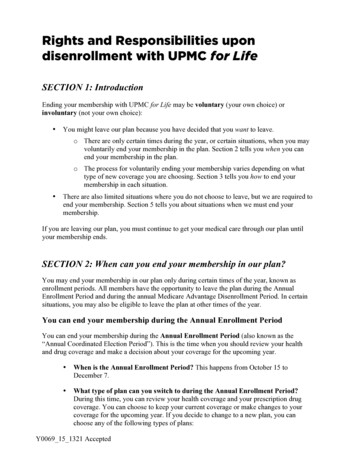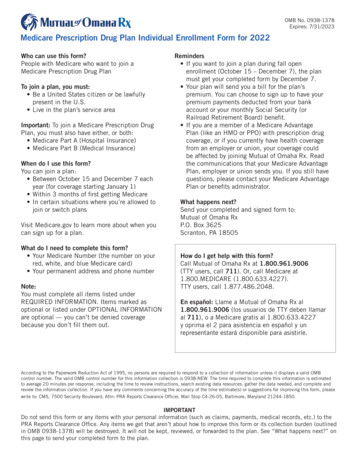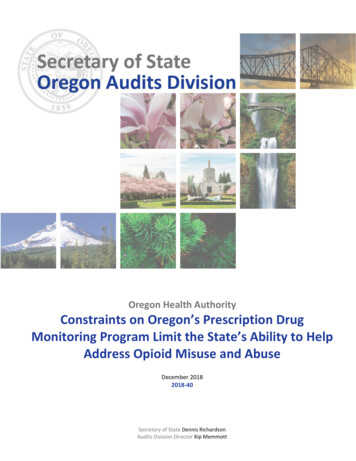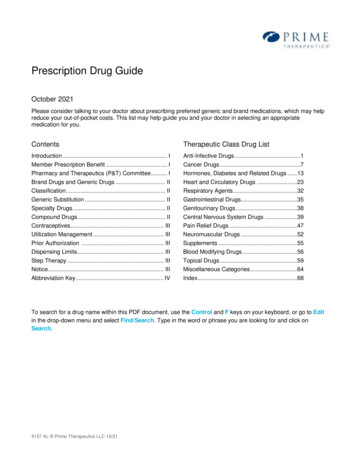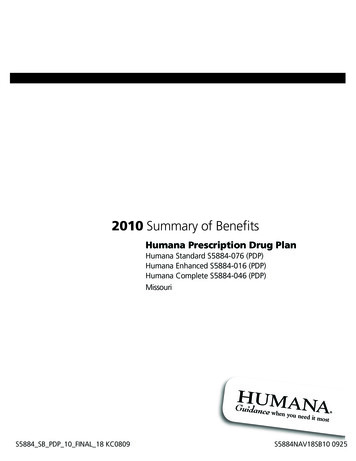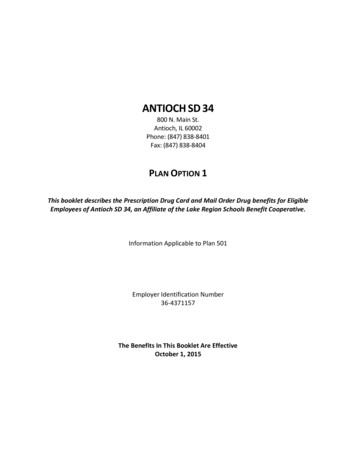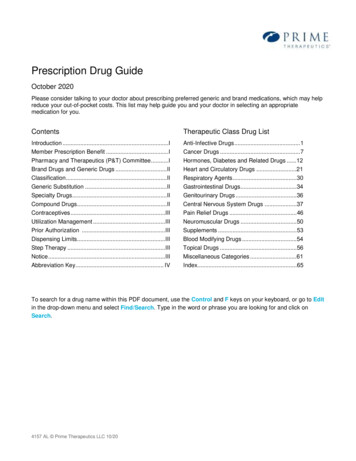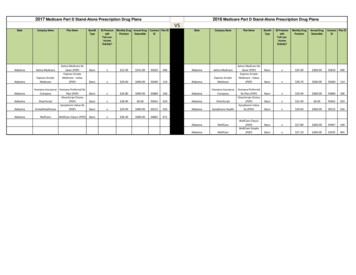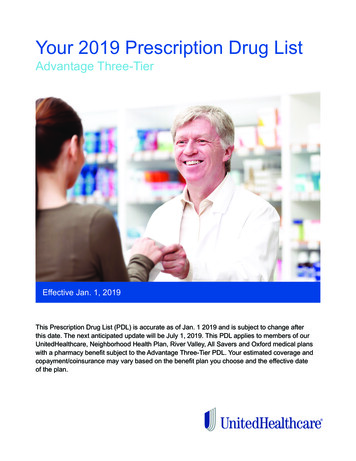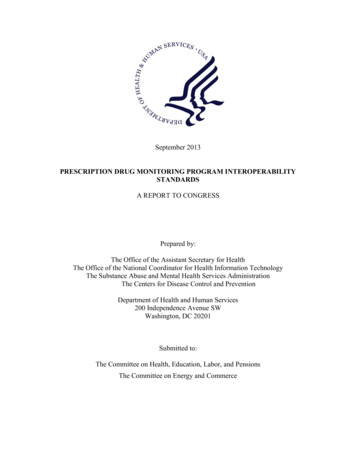
Transcription
September 2013PRESCRIPTION DRUG MONITORING PROGRAM INTEROPERABILITYSTANDARDSA REPORT TO CONGRESSPrepared by:The Office of the Assistant Secretary for HealthThe Office of the National Coordinator for Health Information TechnologyThe Substance Abuse and Mental Health Services AdministrationThe Centers for Disease Control and PreventionDepartment of Health and Human Services200 Independence Avenue SWWashington, DC 20201Submitted to:The Committee on Health, Education, Labor, and PensionsThe Committee on Energy and Commerce
TABLE OF CONTENTSEXECUTIVE SUMMARY . 3INTRODUCTION . 3PURPOSE AND STRUCTURE OF THE REPORT. 3FINDINGS IN THE REPORT . 4I.BACKGROUND . 6Introduction . . . 6Purpose .7Structure of the Report . 8Methods . 8Prescription Drug Monitoring Programs . 9II. REVIEW OF LITERATURE ON PDMP EFFECTIVENESS AND ASSESSMENT OF THE EXTENT OFPROVIDER UTILIZATION . 10III. ASSESSMENT OF LEGAL, TECHNICAL, FISCAL, PRIVACY, AND SECURITYCHALLENGES . .14IV. DISCUSSION OF CURRENT CHALLENGES FOR STATE PDMPS TO INCREASE PRODUCTION ANDDISTRIBUTION OF UNSOLICITED REPORTS . . . 17V. RECOMMENDATIONS FOR ADDRESSING CHALLENGES THAT IMPACT INTEROPERABILITY OFSTATE PDMPS . . 20Report to Congress on PDMP Interoperability Standards2
EXECUTIVE SUMMARYINTRODUCTIONThe United States (U.S.) is in the midst of an unprecedented drug overdose epidemic. Drugoverdose death rates have increased five-fold since 1980.1 In 2009, drug overdose deathsoutnumbered deaths due to motor vehicle crashes for the first time in the U.S. This increase haslargely been fueled by the abuse of opioid analgesics such as oxycodone, hydrocodone, andmethadone.2 Opioid analgesics were involved in 30 percent of drug overdose deaths where adrug was specified in 1999, compared to nearly 60 percent in 2010. In fact, opioid analgesicrelated overdose deaths now outnumber overdose deaths involving all illicit drugs combined.3One of the most promising tools available to reverse the prescription drug abuse epidemic areprescription drug monitoring programs (PDMPs). PDMPs are state-run electronic databases usedto track the dispensing of controlled prescription drugs to patients. PDMPs are designed tomonitor this information for suspected abuse or diversion and can give a provider criticalinformation regarding a patient’s controlled prescription drug history. PDMPs are also used toidentify providers who are contributing to patient risk and not providing appropriate care, serveas a surveillance tool to monitor dispensing and use trends, and evaluate the impact of statepolicies and programs designed to reduce abuse and overdose. As of June 2013, there were 47operational PDMPs in the U.S.4Although significant efforts have been directed to increase the implementation and enhancementof PDMPs in recent years, opportunities exist to increase utilization among providers andstrengthen PDMPs through the use of health information technology (health IT).PURPOSE AND STRUCTURE OF THE REPORTThis report was developed pursuant to Section 1141 of the Food and Drug Administration Safetyand Innovation Act of 2012 (hereafter, referred to as FDASIA).5Section 1141 of FDASIA requires the Secretary of the Department of Health and HumanServices (HHS) to:“submit to the Committee on Health, Education, Labor, and Pensions of the Senate and theCommittee on Energy and Commerce of the House of Representatives a report on enhancingthe interoperability of State prescription drug monitoring programs with other technologiesand databases used for detecting and reducing fraud, diversion, and abuse of prescriptiondrugs The report shall include— (A) an assessment of legal, technical, fiscal, privacy, orsecurity challenges that have an impact on interoperability; (B) a discussion of how State1Warner M, Chen LH, Makuc DM, Anderson RN, Miniño AM. Drug poisoning deaths in the United States, 1980–2008. NCHS data brief, no 81.Hyattsville, MD: National Center for Health Statistics. 2011.2Paulozzi L, Jones C, Mack K, Rudd R; Centers for Disease Control and Prevention (CDC). Vital signs: overdoses of prescription opioidanalgesics—United States, 1999-2008. MMWR Morb Mortal Wkly Rep. 2011;60(43):1487- 1492.3Centers for Disease Control and Prevention. WONDER [database]. Atlanta, GA: US Dept of Health and Human Services, Centers for DiseaseControl and Prevention; 2012. Available at http://wonder.cdc.gov. Accessed January 31, 2013.4Prescription Drug Monitoring Program Training and Technical Assistance Center, Program Status map. Available df. Accessed June 2013.5Public Law 112-144. Food and Drug Administration Safety Innovation Act of 2012. Available at: AW-112publ144.pdfReport to Congress on PDMP Interoperability Standards3
prescription drug monitoring programs could increase the production and distribution ofunsolicited reports to prescribers and dispensers of prescription drugs, law enforcementofficials, and health professional licensing agencies, including the enhancement of suchreporting through interoperability with other States and relevant technology and databases;(C) any recommendations for addressing challenges that impact interoperability of Stateprescription drug monitoring programs in order to reduce fraud, diversion, and abuse ofprescription drugs; and (D) an assessment of the extent to which providers use prescriptiondrug management programs in delivering care and preventing prescription drug abuse.”The report is organized into an Executive Summary, followed by five sections. After theExecutive Summary, the first section contains the purpose, structure, and methods of the report.The second section provides a review of the literature on PDMP effectiveness and an assessmentof the extent to which providers use PDMPs. The third section highlights the current legal,technical, fiscal, privacy, and security challenges facing PDMP interoperability. The fourthsection provides a discussion of how state PDMPs could increase production and distribution ofunsolicited reports. Finally, the fifth section discusses recommendations to address the challengescurrently facing PDMP interoperability.F INDINGSIN THER EPORTAs described in the report, PDMPs face several challenges that currently limit theirinteroperability. The primary challenges center around two main areas: 1) legal and policychallenges; and 2) technical challenges. Addressing these challenges can greatly improve theability of states to establish interoperability and leverage PDMPs to reduce fraud, diversion, andabuse of prescription drugs.The following are recommendations to address identified challenges discussed in the report:Address legal and policy challengesStates should ensure that PDMPs do not restrict access to PDMP data for health careproviders.States should consider implementing laws and policies to increase the use of PDMPs byprescribers, dispensers, and other authorized health care providers, such as requirementsfor prescribers and dispensers to register for the state PDMP.States should consider having authorizing legislation to send unsolicited reports toproviders, licensing boards, regulatory and law enforcement agencies, and public andprivate insurers and pharmacy benefit managers.States should enable real-time access to PDMP data by health care providers. Thisinformation would be reported to the PDMP minutes after a prescription is filled anddispensed from the pharmacy.States, third-party intermediaries, and interstate data sharing hubs should identify thegeneral scope of legal instruments that will facilitate the exchange of PDMP data viathird-party intermediaries, and make available standardized templates for states to use ona shared PDMP resource website.Report to Congress on PDMP Interoperability Standards4
States should ensure that PDMP laws, regulations, policies, and business agreements aredeveloped in such a manner to mitigate privacy and security concerns.Harness advances in health information technology (health IT)PDMPs should apply the latest advances in health IT to incorporate PDMP data directlyinto the workflow of prescribers and dispensers to enable timely access to their patients’controlled prescription drug history information at the point of care. Integrating withhealth IT makes PDMP data timelier and more easily accessible which encouragesroutine checking of the PDMP.HHS, working with the Bureau of Justice Assistance (BJA) within the Department ofJustice (DOJ), should establish an initiative under the Standards & Interoperability (S&I)Framework to assess the current PDMP infrastructure (including interfaces, data formats,data transport and data security protocols) in use or available for use in connectingPDMPs to health information technology systems (e.g., electronic health records (EHRs)and health information exchanges (HIEs) and establishing interoperability.State PDMPs should implement interoperability standards that best support theinformation’s use upon its exchange.o For information exchange from PDMPs to providers or pharmacists, states shouldwork with relevant federal agencies and health care provider groups to harmonizeand adopt standards best equipped to convey prescription information to meettheir various clinical needs. For providers, this could include the use of PDMPdata within EHRs for clinical purposes (e.g., to trigger clinical decision support,update medication history, or inform a health care provider’s treatment plan). Forpharmacists, this could include the use of PDMP data in a pharmacy system toinform pharmacists about previously dispensed prescriptions.o For information exchange between PDMPs (or government-to-governmenttransactions, such as state-to-state notifications), states should continue to followthe National Information Exchange Model (NIEM) PDMP specification and thePrescription Monitoring Program Information Exchange (PMIX) Architecturesupported by the Alliance of States with Prescription Monitoring Programs.o States should also be encouraged to utilize existing infrastructure to support dataexchange with both private sector and government partners.6State PDMPs should implement single sign-on (SSO) capabilities that enable prescribersand dispensers to automatically access the PDMP by signing in to their health IT systems(e.g., EHRs), taking into account the level of trust in the credentialing and authenticationprocess for the health IT systems.State PDMPs should automate the process of generating alerts to notify prescribers anddispensers of possible doctor shoppers. Automation helps to minimize costs and staffresources, while increasing the rate of notification. Health IT is key to automating thisprocess and enabling PDMP data to be more readily available at the point of care.6National standards adopted for meaningful use and the PDMP initiative under the Standards and Interoperability (S&I) Framework from theSAMHSA/ONC Enhancing Access to PDMP Project can be referenced for more detailed information on this exchange use case(http://wiki.siframework.org/Prescription Drug Monitoring Program Initiative).Report to Congress on PDMP Interoperability Standards5
I. BACKGROUNDINTRODUCTIONThe United States is in the midst of an unprecedented drug overdose epidemic. Drug overdosedeath rates have increased five-fold since 1980.7 In 2009, drug overdose deaths outnumbereddeaths due to motor vehicle crashes for the first time in the U.S. Prescription drugs, especiallyopioid analgesics, have been increasingly involved in drug overdose deaths in the last decade.8Opioid analgesics were involved in 30 percent of drug overdose deaths where a drug wasspecified in 1999, compared to nearly 60 percent in 2010. Between 1999 and 2010, over 125,000people in the U.S. died from an overdose involving an opioid analgesic – far exceeding deathsfrom any other drug or drug class, licit or illicit, during this time period. In fact, opioid analgesic-related overdose deaths now outnumber overdose deaths involving all illicit drugs combined.9In addition to overdose deaths, nonmedical use of prescription drugs – use without a prescriptionor use for the feeling or experience the drug caused – and the health and economic consequencesassociated with it are significant. In 2011, more than 14.5 million people 12 years and olderreported nonmedical use of psychotherapeutic prescription drugs (pain relievers, sedatives,tranquilizers, and stimulants) in the past year.10 Rates of emergency department (ED) visitsassociated with pharmaceutical misuse or abuse increased 114 percent between 2004 and 2011while rates for illicit drugs remained stable. By 2011, more than 1.4 million ED visits annuallywere related to the misuse or abuse of pharmaceuticals – with over 420,000 involving opioidanalgesics and over 425,000 involving benzodiazepines.11 Substance abuse treatment admissionsfor opioid analgesic abuse have also increased significantly over the last decade.12 It is estimatedthat the abuse of opioid analgesics results in over 72 billion in medical costs each year.13 Inmany instances, public payers are responsible for covering the costs of prescription drugabuse.14,15Coinciding with the rise in opioid-related morbidity and mortality is an increase in opioidanalgesic prescribing, primarily for chronic non-cancer pain.16,17,18 An analysis by the Centers for7Warner M, Chen LH, Makuc DM, Anderson RN, Miniño AM. Drug poisoning deaths in the United States, 1980–2008. NCHS data brief, no 81.Hyattsville, MD: National Center for Health Statistics. 2011.8Paulozzi L, Jones C, Mack K, Rudd R; Centers for Disease Control and Prevention (CDC). Vital signs: overdoses of prescription opioidanalgesics—United States, 1999-2008. MMWR Morb Mortal Wkly Rep. 2011;60(43):1487- 1492.9Centers for Disease Control and Prevention. WONDER [database]. Atlanta, GA: US Dept of Health and Human Services, Centers for DiseaseControl and Prevention; 2012. Available at http://wonder.cdc.gov. Accessed January 31, 2013.10Substance Abuse and Mental Health Services Administration. Results from the 2011 National Survey on Drug Use and Health: Detailed tables.In NSDUH Series H-41. Rockville, MD: Substance Abuse and Mental Health Services Administration, Center for Behavioral Health Statisticsand Quality. 2012.11Substance Abuse and Mental Health Services Administration, Center for Behavioral Health Statistics and Quality. The DAWN Report:Highlights of the 2011 Drug Abuse Warning Network (DAWN) Findings on Drug-Related Emergency Department Visits. Rockville, MD.12Substance Abuse and Mental Health Services Administration, Center for Behavioral Health Statistics and Quality. Treatment Episode Data Set(TEDS): 2000-2010. National Admissions to Substance Abuse Treatment Services. DASIS Series S-61, HHS Publication No. (SMA) 12-4701.Rockville, MD: Substance Abuse and Mental Health Services Administration, 2012.13Coalition Against Insurance Fraud. Prescription for peril: how insurance fraud finances theft and abuse of addictive prescription drugs.Washington, DC: Coalition Against Insurance Fraud; 2007. Available at ion.pdf.Accessed October 2012.14Government Accountability Office. Medicaid: Fraud and abuse related to controlled substances identified in selected states. Washington, DC;2009.15Government Accountability Office. Medicare Part D: Instances of questionable access to prescription drugs. Washington, DC; 2011.16Braden JB, Fan MY, Edlund MJ, Martin BC, DeVries A, Sullivan MD. Trends in use of opioids by non-cancer pain type 200-2005 amongArkansas Medicaid and HealthCore enrollees: Results from the TROUP Study. J Pain. 2008;9(11):1026-1035.17Sullivan MD, Edlund MJ, Fan MY, DeVries A, Braden JB, Martin BC. Trends in use of opioids for non-cancer pain conditions 2000-2005 incommercial and Medicaid insurance plans: The TROUP Study. Pain. 2008;138(2):440-449.Report to Congress on PDMP Interoperability Standards6
Disease Control and Prevention (CDC) found that opioid analgesic sales increased four-foldbetween 1999 and 2010, and this was paralleled by an increase in opioid overdose deaths andsubstance abuse treatment admissions during the same time period.19 A similar trend was notedfor rates of chronic nonmedical use of opioid analgesics, opioid sales, opioid overdose deaths,and substance abuse treatment admissions between 2002 and 2010.20 Other studies have reportedthat increased opioid prescribing is associated with increased nonmedical use and ED visits.21,22The problem of prescription drug abuse and overdose is complex and multi-faceted. Theprevalence and type of health consequences vary depending on age, gender, race, ethnicity,geography, socioeconomic factors, and diagnosed medical conditions. There are multiple driversof the problem, and an effective response requires a multi-pronged, targeted, and sustainedapproach that must also balance the legitimate needs of patients and ensure that access to paintreatment is not unnecessarily restricted. One of the most promising tools available to reverse theprescription drug abuse epidemic and improve patient care is the prescription drug monitoringprogram (PDMP) – state-run electronic databases used to track the dispensing of controlledprescription drugs to patients.As PDMP systems have evolved outside the health IT ecosystem, significant barriers tointeroperability have resulted. For example, one of the current technical barriers tointeroperability is the lack of standard methods to exchange and integrate data from PDMPs tohealth IT systems, so that it can be used in a timely and convenient manner. Currently,prescribers and dispensers must either interrupt their workflow and log on to a separate system toaccess the PDMP or write or dispense prescriptions without consulting the PDMP. In response,HHS is working with colleagues in the BJA and the Alliance of States with Prescription DrugMonitoring Programs along with the PDMP Center of Excellence and the PDMP TechnicalTraining and Assistance Center, both located at Brandeis University, and other stakeholders tofacilitate the development of recommendations and practices to improve PDMP to health ITconnectivity and integration.PURPOSE OF THE REPORTThis report was developed pursuant to Section 1141 of the Food and Drug Administration Safetyand Innovation Act of 2012 (hereafter, referred to as FDASIA).23Section 1141 of FDASIA requires the Secretary of HHS to:18Food and Drug Administration. Risk Evaluation and Mitigation Strategies (REMS) for Extended-Release and Long-Acting Opioid AnalgesicsBriefing Material. 2010. Available Paulozzi LJ, Jones C, Mack K, Rudd R; Centers for Disease Control and Prevention (CDC). Vital signs: overdoses of prescription opioid painrelievers—United States, 1999-2008. MMWR Morb Mortal Wkly Rep. 2011;60(43):1487- 1492.20Jones CM. Frequency of prescription pain reliever nonmedical use: 2002-2003 and 2009-2010. Arch Intern Med. 2012;172(16):1265-1267.21Wisniewski AM, Purdy CH, Blondell RD. The epidemiologic association between opioid prescribing, non-medical use, and emergencydepartment visits. J Addict Dis. 2008;27(11):1-11.22Braden JB, Russo J, Fan MY, et al. Emergency department visits among recipients of chronic opioid therapy. Arch Intern Med 2010;170:142532.23Public Law 112-144. Food and Drug Administration Safety Innovation Act of 2012. Available at: AW-112publ144.pdfReport to Congress on PDMP Interoperability Standards7
“submit to the Committee on Health, Education, Labor, and Pensions of the Senate and theCommittee on Energy and Commerce of the House of Representatives a report on enhancingthe interoperability of State prescription drug monitoring programs with other technologiesand databases used for detecting and reducing fraud, diversion, and abuse of prescriptiondrugs The report shall include— (A) an assessment of legal, technical, fiscal, privacy, orsecurity challenges that have an impact on interoperability; (B) a discussion of how Stateprescription drug monitoring programs could increase the production and distribution ofunsolicited reports to prescribers and dispensers of prescription drugs, law enforcementofficials, and health professional licensing agencies, including the enhancement of suchreporting through interoperability with other States and relevant technology and databases;(C) any recommendations for addressing challenges that impact interoperability of Stateprescription drug monitoring programs in order to reduce fraud, diversion, and abuse ofprescription drugs; and (D) an assessment of the extent to which providers use prescriptiondrug management programs in delivering care and preventing prescription drug abuse.”STRUCTURE OF THE REPORTThe report is organized into an Executive Summary, followed by five sections. After theExecutive Summary, the first section contains the purpose, structure, and methods of the report.The second section provides a review of the literature on PDMP effectiveness and an assessmentof the extent to which providers use PDMPs. The third section highlights the current legal,technical, fiscal, privacy, and security challenges facing PDMP interoperability. The fourthsection provides a discussion of how state PDMPs could increase production and distribution ofunsolicited reports. Finally, the fifth section discusses recommendations to address the challengescurrently facing PDMP interoperability.METHODSThe report was developed by the Office of the Assistant Secretary of Health (OASH), the Officeof the National Coordinator for Health Information Technology (ONC), the Substance Abuseand Mental Health Services Administration (SAMHSA), and the Centers for Disease Control andPrevention (CDC). Information contained in the report comes from three main sources: 1)Workgroup recommendations and pilot project findings conducted as part of the ONC/SAMHSAEnhancing Access to PDMPs using Health IT (the “Enhancing Access”) project (see additionalinformation below on this project); 2) information provided by the Prescription Drug MonitoringProgram Center of Excellence at Brandeis University, the Training and Technical Assistanceprovider on PDMPs for the BJA that is also located at Brandeis University; and 3) a review ofthe available literature on PDMPs.Enhancing Access ProjectONC, in collaboration with SAMHSA, CDC, and the Office of National Drug Control Policy(ONDCP), launched the Enhancing Access project in 2011. This 18-month effort was designedto improve timely access to PDMP data by prescribers and dispensers by exploring ways toReport to Congress on PDMP Interoperability Standards8
integrate PDMP data into existing technologies (e.g., EHRs, HIEs, and pharmacy dispensingsystems) which are part of the normal clinical workflow.As part of the Enhancing Access project, work groups comprised of stakeholders from the PDMPand clinical community were convened to identify challenges and recommend solutions toincrease timely use of PDMP data. The work groups developed a set of recommendationscritical to increasing PDMP use and moving toward greater integration with health IT, such asautomating unsolicited reporting, providing real-time access to PDMP data to providers, andintegrating access to PDMP data into the clinical workflow. The Work Group Reportsummarizing the findings, recommendations, and work group artifacts was finalized andpublished on the ONC website in August 2012.24The Enhancing Access project also conducted pilot studies25 designed to test the feasibility ofleveraging health IT and information exchange to improve timely access to PDMPs at the pointof care and the point of dispensing. The pilots tested linkages between state PDMPs and healthIT systems, and the results demonstrated the value that increased access to state PDMP data hasat the point of care. For example, pilot participants reported that the new functionalitystreamlined their clinical workflows, made PDMP data easier to access, and helped improveclinical decision making.Additionally, the PDMP Standards & Interoperability (S&I) Initiative26 was launched as part ofthe Enhancing Access effort to bring together the PDMP and health IT communities to evaluatedata format standards for exchanging patient information between PDMP and provider EHRsystems. This S&I initiative sought input on how best to both describe and exchange this data,starting from the PDMP Work Group recommendations released in August 2012.PRESCRIPTION DRUG MONITORING PROGRAMSPDMPs are state-based electronic databases that track the dispensing of controlled substances ina state. They are designed to monitor this information for suspected abuse or diversion (i.e., thechanneling of the drug into an illegal use) and to give providers critical information regardingtheir patients’ controlled prescription drug history. This information can have a direct impact onreducing a patient’s risk for overdose and provides an opportunity to intervene and refer patientsfor substance use disorder treatment, when necessary.The first PDMP was created in 1939 in California. In 1992, only 10 operational programsexisted. As of June 2013, there are 47 operational programs.27 PDMPs receive data on dispensedcontrolled substances from pharmacies and in some states from physicians or other providerswho dispense controlled substances directly from their office. This information is then compiledin the PDMP database and made available to prescribers, dispensers, and other authorized /work group document integrated paper final.pdfhttp://www.healthit.gov/PDMP26The S&I Framework is an open forum and collaborative community, with participation from key stakeholders in the public sector and privateindustry, http://wiki.siframework.org/Prescription Drug Monitoring Program n Drug Monitoring Program Initiative.27Prescription Drug Monitoring Program Training and Technical Assistance Center, Program Status map. Available df. Accessed June 2013.25Report to Congress on PDMP Interoperability Standards9
typically through a Web-based portal. PDMPs are housed in various agencies within states.Currently, 39 state PDMPs are housed in a state health department, single state authority ondrugs and alcohol, or board of pharmacy; 7 in a law enforcement or public safety agency; 2 in aprofessional licensing agency; and 1 in a consumer protection agency.28PDMPs serve many purposes in addition to their clinical role. They are used to identify providerswho are contributing to patient risk and not providing appropriate care, serve as a surveillancetool to monitor dispensing and use trends, assist in investigating drug diversion, and are used toevaluate the impact of state policies and programs designed to reduce abuse and overdose.29PDMPs were originally designed as passive systems where authorized users were required tosolicit information from the PDMP. However, in recent years, many PDMPs have movedtowards proactive use of the data via unsolicited reporting.30 Unsolicited reporting, also calledproactive reporting, is a product of a PDMP where the prescription information is analyzed byPDMP staff and questionable activities are then reported to appropriate personnel based onthresholds established by the PDMP.31 Recipients of these reports include prescribers,pharmacists, investigative agencies, and licensure boards. A 2011 survey conducted by thePDMP Center of Excellence at Brandeis University of 38 states found that 30 state PDMPs wereauthorized to provide unsolicited reports to medical providers, yet only 16 were actually doingso. A smaller number were also providing such reports to law enforcement agencies (eight) andlicensing boards (seven).32II. REVIEW OF LITERATURE ON PDMP EFFECTIVENESS AND ASSESSMENT OF THEEXTENT OF PROVIDER UTILIZATIONREVIEW OF THE LITERATURE ON PDMP EFFECTIVENESSThe literature on the impact of PDMPs on the abuse of opioid analgesics is increasing. Researchconsistently suggests that PDMPs reduce the prescribing of Schedule II opioid analgesics.33,34However, one study indicated there were compensatory increases in the prescribing of ScheduleIII opioids and no change in total prescribing in states with PDMPs compared to those withoutone.35 Another study found that states with PDMPs had lower substance abuse treatment rates foropioids from 1997 to 2003 compared to states without PDMPs.36 A more recent analysis based28National Alliance for Model State Drug Laws. “Prescription drug abuse, addiction, and diversion: overview of state legislative and vents/NAMSDL%20With%20the%20N
PRESCRIPTION DRUG MONITORING PROGRAM INTEROPERABILITY STANDARDS . A REPORT TO CONGRESS . Prepared by: The Office of the Assistant Secretary for Health . The Office of the National Coordinator for Health Information Technology . The Substance Abuse and Mental Health Services Administration . The Centers for Disease Control and Prevention
